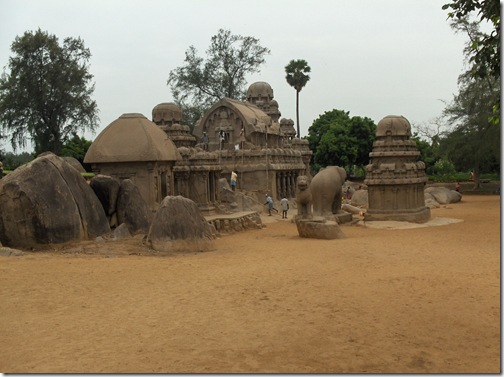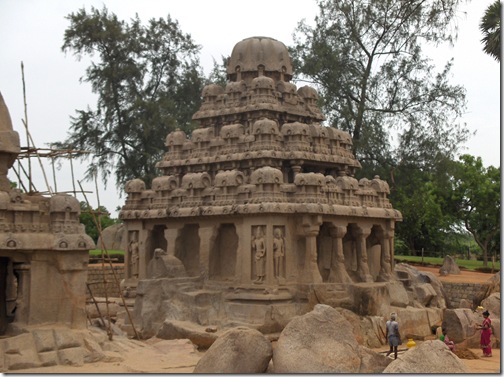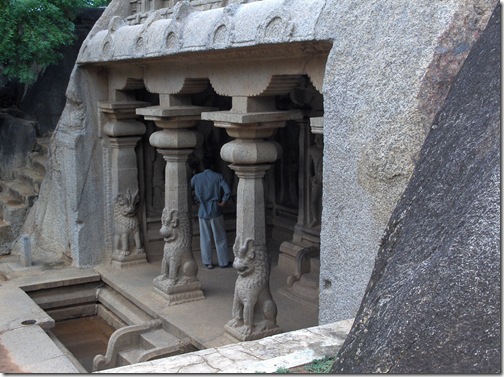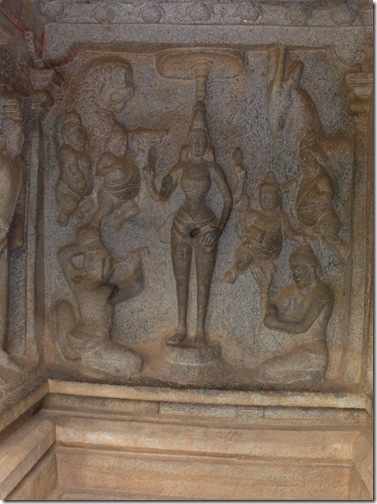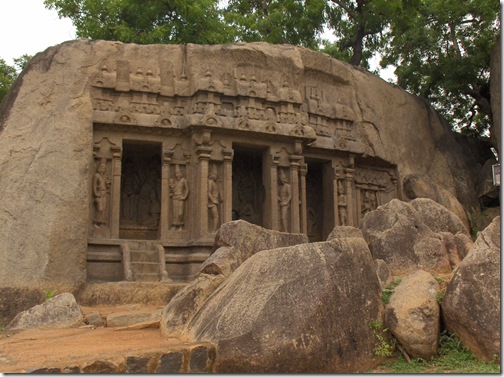Mamallapuram (also called Mahabalipuram) is a tourist town about 60 km south of Chennai. This was a major port in the 7th century under the Pallava dynasty, famous now for its rock carvings from this period.
Good references to Mamallapuram and to the Pallavas can be found at Wikipedia and Wikitravel.
In early August, my wife Carol and I went to Mamallapuram for a ‘vacation’ from our retirement in Tiruvannamalai, Tamil Nadu. I will make two posting from this. This posting shows photos of the stone carvings. The other posting is “Mamallapuram -Tamil Nadu Beach Resort and Tourist Town.”
History of Monuments (from wikipedia)
The monuments are mostly rock-cut and monolithic, and constitute the early stages of Dravidian architecture wherein Buddhist elements of design are prominently visible. They are represented by cave temples, monolithic rathas (chariots), sculpted reliefs and structural temples. The pillars are of the Dravidian order. The sculptures are excellent examples of Pallava art.
It is believed by some that this area served as a school for young sculptors. The different sculptures, some half finished, may have been examples of different styles of architecture, probably demonstrated by instructors and practiced on by young students. This can be seen in the Pancha Rathas where each Ratha is sculpted in a different style.
The Shore Temple
The Shore Temple is the best known temple in the area, and the place where we started.
The Shore Temple is really two temples, one for Siva and one for Vishnu.
Exposed to the wind from the sea for 1300 years, many of the carvings have become very worn and eroded.
The Siva altar and lingam.
The Vishu altar.
Below is a stone creature, a lion (?), with an archer sitting on its knee. There is a carved area for a god or shrines in the lion. No shrine, though.
Looking towards the town from the Shore Temple.
The Pancha Rathas (The Five Rathas)
When I first saw these stone buildings I wondered if perhaps they were carved later, they were so perfect. I guess the current idea is that these were carved as practice exercises and examples for the rock carving students.
There are five buildings, all carved from single rocks, each in a different style.
Krishna’s Butterball
After we left the Five Rathas, we went to a central area in the city where there was a park area with many carvings. This was obviously a main area 1300 years ago.
The giant rock is balanced in place here called ‘Krishna’s Butterball’, and attracts many visitors. It is visible from the street and is the first area here to which many visitors will go.
Here is Carol holding up Krishna’s Butterball. We saw later that this is a popular pose for photos.
Here is a view from an area to the North.
Here a group of travelers ‘holding the rock up’.
Arjuna’s Penance – The Descent of the Ganges
This is to the South of Krishna’s butterball, and accessible from the road.
Immediately before the carved wall, there is an ancient figure of a monkeys caring for each other, grooming the mother nursing a baby.
These life-sized carvings of elephants are shown in many pictures of Mamallapuram.
In the center, in a crack, are a series of Nagas, Snake Gods. I think this symbolizes the Ganges.
To the left, left of the shrine is a sitting figure, said to be Arjuna, engaged in tapas, penance.
Varaha Cave Temple
This is carved in the rock, accessible to the south, from Krishna’s Butterball.
We noticed throughout this temple, in the groins of some of the main figures, dark spots, where ghee lamps must have been burned.
The wonderfully detailed carvings here are unaffected by the years, since they are in a protected location.
Other Temples Cut into the Stone
Cut from One Single Rock
This temple is carved from a single stone, in a style that reminds one of those in the Five Rathas. If you examine it, you cannot see any marks where stones would have been joined together.
Ganesh in the Temple shrine.
Nearby, these rocks have had big pieces taken from them. You can see the remaining straight side. They are about 20 feet high. How did they carry the pieces that were removed?
Temple cut into Rock Face
Next to Arjuna’s Pennance is another temple carved into the rock. This is accessible from the road.
Another Bas Relief Elephant
This is to the North from Krishna’s Butterball.
Carol with elephant.
Yet another Temple carved from a Single Rock
Also to the North from Krishna’s Butterball.
Lingam in the central shrine.
A well or catchment basin carved into the rock nearby.
A Goporum (Gate) atop the Rock above Arjuna’s Pennance.
Details of a column
A goat enjoys the Goporum
Tiger Cave
Tiger Cave is perhaps 4 km North of town. The animals depicted are really not tigers, but legendary beasts.
Long ago, the locals would climb this rock to watch for ships coming in, then light a signal fire.
Mamallpuram is still a place were you can find many stone carvers. Since these skills are passed from father to son, I wonder if any are descended from the stone carvers whose work we saw from 1300 years ago?
As you will see in the next part of this posting, today they offer tourists instruction in this stone carving.
Related Post: Mamallapuram – Tamil Nadu Beach Resort









